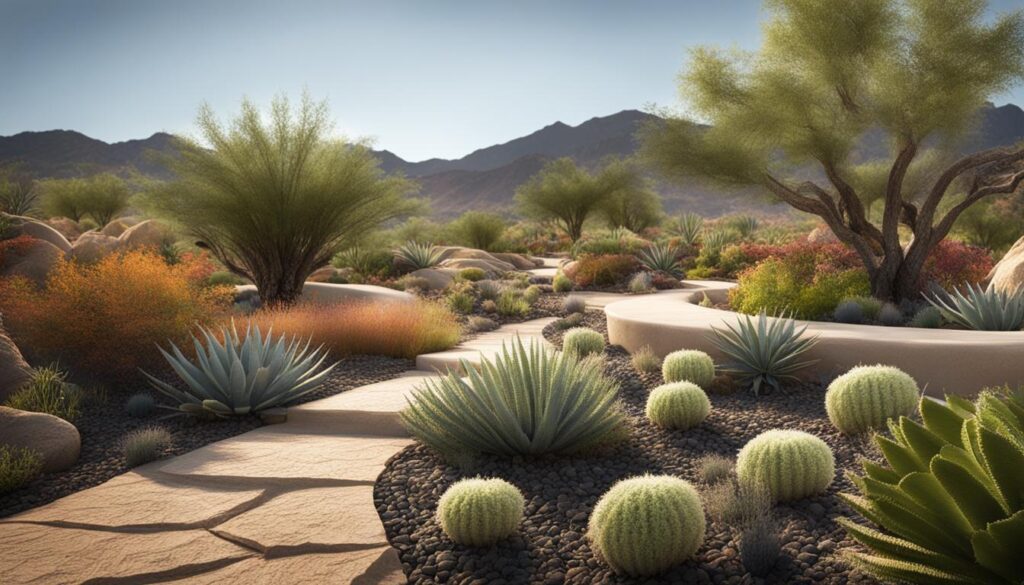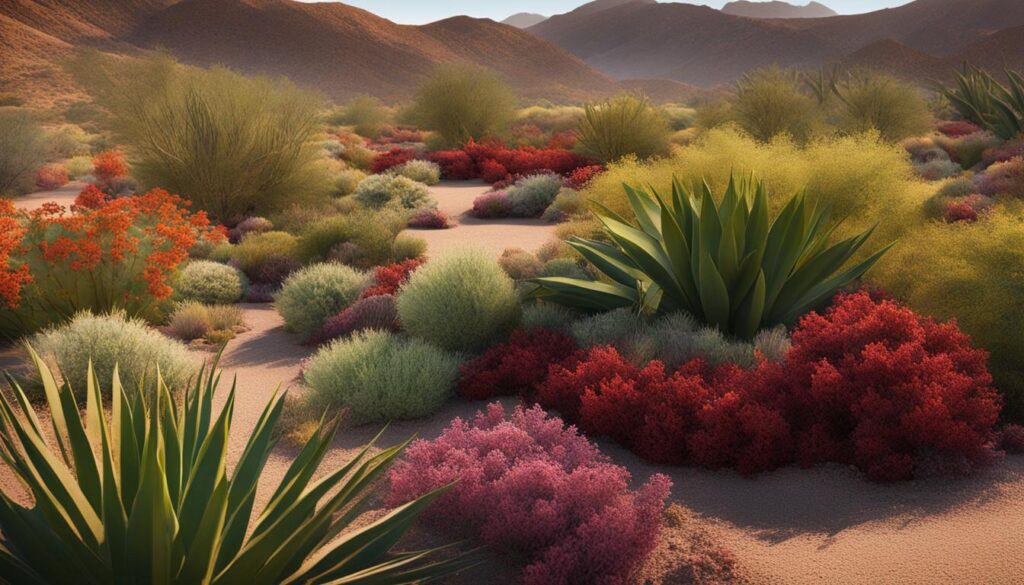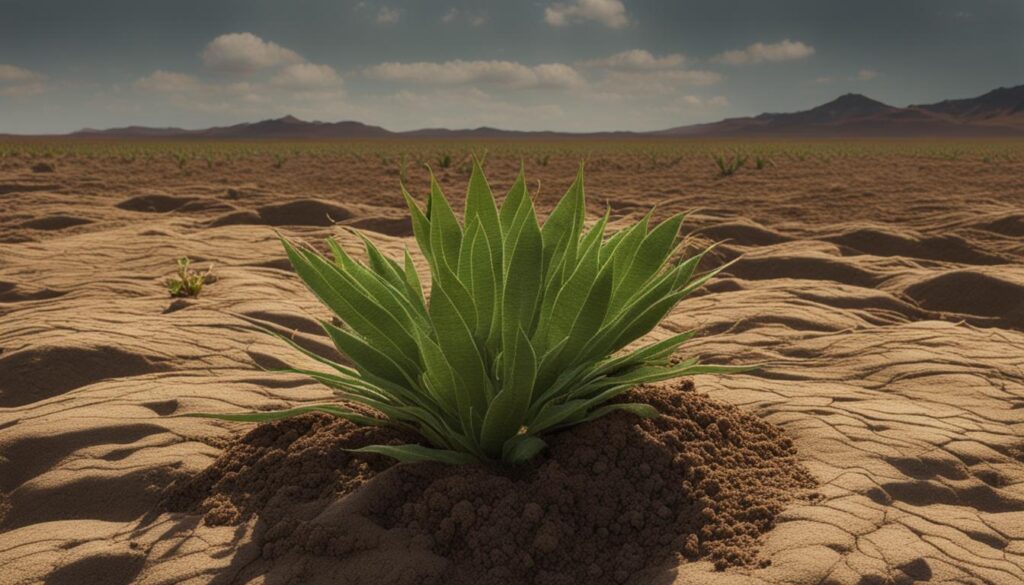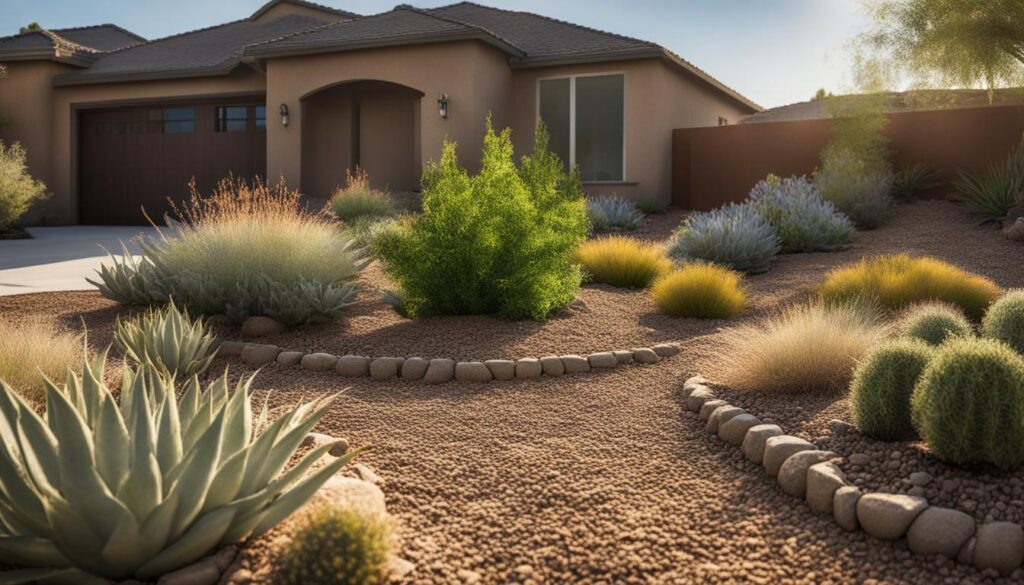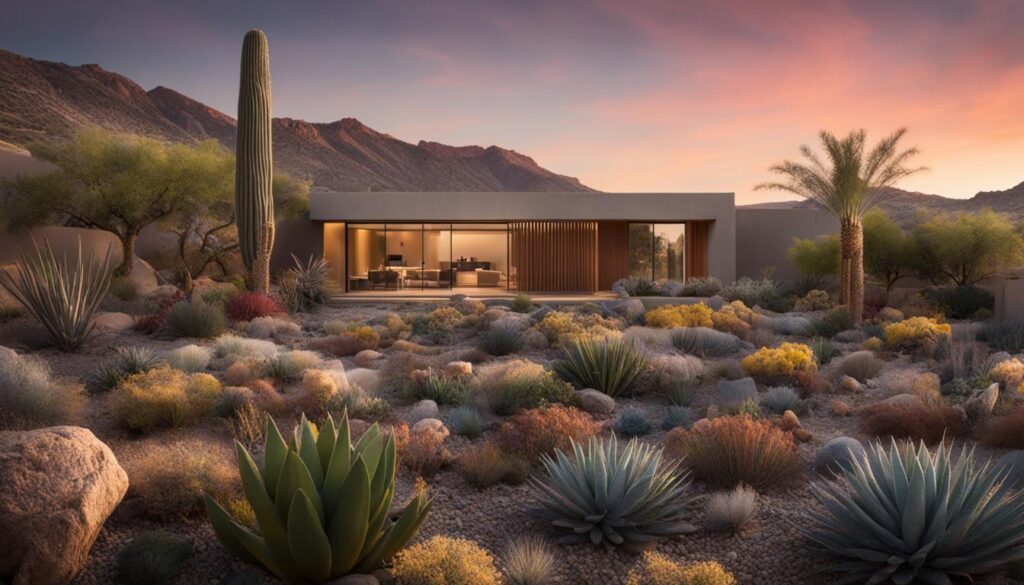Discover the groundbreaking solution to water-efficient gardening in the United States. Climate adaptive soil is revolutionizing xeriscaping, a landscaping technique that focuses on water efficiency. By incorporating climate adaptive soil into your xeriscaping projects, you can create beautiful and sustainable outdoor spaces without compromising on aesthetics. Say goodbye to excessive watering and hello to a thriving garden that adapts to the unique needs of plants in arid or drought-prone regions.
Key Takeaways:
- Climate adaptive soil optimizes water efficiency in your garden
- Xeriscaping is a sustainable landscaping technique that focuses on creating water-efficient outdoor spaces
- Climate adaptive soil retains moisture effectively and minimizes water loss
- By using climate adaptive soil, you can reduce water usage and maintenance requirements
- Embrace the future of landscaping with climate adaptive soil and create a greener, more sustainable environment
The Importance of Water Conservation in Landscaping
Water conservation is a crucial aspect of landscaping, particularly in regions where water scarcity is a growing concern. By implementing sustainable practices in your garden, you can create a beautiful landscape while minimizing water usage and reducing your environmental impact.
Optimal irrigation systems: Investing in efficient irrigation systems, such as drip irrigation or smart sprinklers, can significantly reduce water waste by delivering water directly to the roots of plants, minimizing evaporation and runoff.
Mulching: Using organic mulch around plants helps to retain moisture in the soil, reducing the need for frequent watering and preventing weed growth.
Native and drought-tolerant plants: Choosing plants that are well-adapted to your local climate and require less water can greatly reduce your water consumption. Native plants are naturally suited to the local environment and are often more drought-tolerant.
Grouping plants with similar water needs: By grouping plants with similar water requirements together, you can ensure that each plant receives the appropriate amount of water without over or under watering.
Proper watering techniques: Watering early in the morning or late in the evening helps to minimize evaporation. Additionally, watering deeply and infrequently encourages plants to develop deep root systems, making them more resilient to drought conditions.
By incorporating these practices into your landscaping, you can contribute to water conservation efforts and create a sustainable outdoor space that thrives while minimizing water usage.
“Water conservation is essential for creating a sustainable landscape that not only benefits the environment but also saves you money on water bills.”
– Landscaping Professional
The Benefits of Water Conservation in Landscaping
- Reduces water usage and promotes environmental sustainability.
- Lowers water bills and saves money in the long run.
- Preserves local water resources and supports the health of ecosystems.
- Creates a resilient and drought-tolerant landscape that requires less maintenance.
- Contributes to a greener and more sustainable future for our planet.
| Water Conservation Tips | Benefits |
|---|---|
| Install efficient irrigation systems. | Reduces water waste and saves money on water bills. |
| Use organic mulch. | Retains moisture in the soil and prevents weed growth. |
| Choose native and drought-tolerant plants. | Requires less water and adapts better to local climate conditions. |
| Group plants with similar water needs. | Ensures efficient water usage and prevents overwatering. |
| Implement proper watering techniques. | Reduces water evaporation and promotes deep root growth. |
Understanding Xeriscaping and its Benefits
Xeriscaping is a landscaping technique that focuses on creating water-efficient and low-maintenance outdoor spaces. It involves selecting plants that are well-suited to the local climate and require minimal watering, along with incorporating hardscapes, rocks, and native vegetation. The benefits of xeriscaping include reduced water usage, lower maintenance requirements, improved soil health, and the preservation of local ecosystems. By embracing xeriscaping, you can achieve a beautiful and sustainable landscape that thrives in water-limited environments.
The Benefits of Xeriscaping:
- Reduced water usage: Xeriscaping significantly reduces the need for irrigation, saving water and lowering your water bills.
- Lower maintenance requirements: With xeriscaping, you’ll spend less time and effort on maintaining your landscape. The carefully selected plants are adapted to the local climate and require minimal care.
- Improved soil health: Xeriscaping promotes healthy soil by incorporating organic matter, improving its structure and nutrient-holding capacity. This enhances plant growth and overall ecosystem health.
- Preservation of local ecosystems: By using native plants in xeriscaping, you help preserve the local biodiversity and protect the ecosystems that depend on them.
Whether you live in an arid region or want to create a more sustainable landscape, xeriscaping offers numerous advantages. By minimizing water usage and maintenance while enhancing soil health and supporting local ecosystems, xeriscaping allows you to create a beautiful outdoor space that is both environmentally friendly and visually appealing.
Now that you understand the benefits of xeriscaping, let’s explore how climate adaptive soil plays a crucial role in creating water-efficient landscapes.
The Role of Climate Adaptive Soil in Xeriscaping
Xeriscaping, a water-efficient landscaping technique, requires the use of specialized soil that can adapt to the unique needs of plants in arid regions. This is where climate adaptive soil comes into play. Climate adaptive soil plays a crucial role in xeriscaping by providing a foundation for water-efficient landscaping. Its ability to retain moisture effectively and release it slowly to plant roots ensures optimal hydration while minimizing water loss.
One of the key benefits of climate adaptive soil is its ability to promote proper drainage, preventing waterlogging and root rot. This is essential for the health and survival of plants in regions with limited water availability. Furthermore, climate adaptive soil is designed to adapt to changing weather conditions, making it an ideal choice for xeriscaping projects that need to withstand fluctuating climates.
By using climate adaptive soil in xeriscaping, homeowners can create resilient and thriving landscapes that require less water and maintenance. This not only helps conserve water but also contributes to the overall sustainability of outdoor spaces. With climate adaptive soil, you can achieve a beautiful and water-efficient garden that thrives even in the most challenging environments.
The Benefits of Climate Adaptive Soil in Xeriscaping
Using climate adaptive soil in xeriscaping projects offers a range of benefits:
- Water Efficiency: Climate adaptive soil helps reduce water usage by retaining moisture and slowly releasing it to plant roots, minimizing water loss through evaporation or runoff.
- Improved Soil Health: The unique composition of climate adaptive soil enhances soil structure and nutrient-holding capacity, promoting healthy root growth and overall plant development.
- Reduced Maintenance: Xeriscaped landscapes with climate adaptive soil require less maintenance due to improved water retention and plant adaptability, saving you time and effort.
- Preservation of Ecosystems: By minimizing water usage and supporting the growth of native and drought-tolerant plants, climate adaptive soil helps preserve local ecosystems and promotes biodiversity.
Overall, the use of climate adaptive soil in xeriscaping projects enhances water efficiency, improves soil health, reduces maintenance requirements, and contributes to the long-term sustainability of outdoor spaces. With its numerous benefits, climate adaptive soil is a game-changer for creating beautiful and eco-friendly landscapes.
How Climate Adaptive Soil Works
Climate adaptive soil is a remarkable innovation in the field of xeriscaping, offering a solution to water conservation in arid or drought-prone regions. Its unique composition and properties enable optimal hydration for plants while reducing water loss. To understand how climate adaptive soil works, let’s explore its key features:
The formulation
Climate adaptive soil is carefully formulated with a blend of organic matter, minerals, and water-absorbing compounds. This combination allows the soil to efficiently retain moisture and release it gradually to the plant roots. The water-absorbing compounds further promote healthy root growth and improve the overall structure of the soil.
Water retention
One of the primary functions of climate adaptive soil is its ability to retain moisture effectively. The soil acts as a reservoir, holding water for extended periods and reducing the need for frequent watering. This feature not only conserves water but also ensures that plants receive a constant supply of moisture for optimal growth.
Optimal hydration
Climate adaptive soil provides plants with optimal hydration by releasing water slowly and evenly. This helps prevent overwatering and under watering, which can both be detrimental to plant health. By maintaining a balanced moisture level in the soil, climate adaptive soil supports the long-term survival and vitality of plants in xeriscaping projects.
Overall, climate adaptive soil revolutionizes the way we approach water-efficient landscaping. Its unique features and capabilities make it an excellent choice for creating sustainable and thriving outdoor spaces in water-limited environments.
Disclaimer: The image above is for visual representation purposes only and may not depict the exact appearance of climate adaptive soil.
Benefits of Climate Adaptive Soil for Xeriscaping
Using climate adaptive soil in your xeriscaping project offers a multitude of benefits. With its unique properties and innovative design, this soil can significantly improve the efficiency and sustainability of your outdoor space. Here are some key advantages:
1. Water Efficiency
One of the primary benefits of climate adaptive soil is its ability to optimize water usage. The soil is formulated to retain moisture effectively and release it slowly to plant roots, ensuring optimal hydration while minimizing water loss. This means that you can achieve healthy and vibrant plants with less frequent watering, resulting in significant water savings.
2. Enhanced Soil Health
Climate adaptive soil also improves the overall health of your soil. It enhances its structure and nutrient-holding capacity, promoting strong root development and plant growth. The soil’s ability to retain moisture and support healthy roots creates a favorable environment for your plants to thrive. Additionally, the improved soil health contributes to the long-term sustainability of your xeriscaped landscape.
3. Low Maintenance
Xeriscaping is known for its low-maintenance nature, and the use of climate adaptive soil further reduces the need for ongoing maintenance. By retaining moisture and providing optimal hydration to plants, the soil minimizes the need for frequent watering. This not only saves you time and effort but also reduces water usage and associated costs. With climate adaptive soil, you can enjoy a beautiful and sustainable landscape with minimal maintenance requirements.
By incorporating climate adaptive soil into your xeriscaping project, you can achieve water efficiency, improve soil health, and reduce maintenance needs. This innovative soil technology is a game-changer for creating thriving and sustainable outdoor spaces, even in water-limited environments.
Incorporating Climate Adaptive Soil in Xeriscaping Projects
When it comes to incorporating climate adaptive soil in xeriscaping projects, there are several key steps you can take to ensure success. First, it’s important to prepare the existing soil by removing any weeds and debris and improving its drainage if necessary. This will create a clean and suitable foundation for your xeriscaping project.
Next, you’ll want to mix the climate adaptive soil with the existing soil. This will help to provide a balanced and nutrient-rich environment for your plants. Proper blending and distribution of the soil mixture is crucial for optimal growth and water efficiency.
When selecting plants for your xeriscaping project, it’s important to choose native species that are well-suited to your local climate. Native plants are naturally adapted to the environmental conditions in your area, making them more resilient and requiring less water. Additionally, consider incorporating drought-tolerant species that can thrive in water-limited environments.
To further enhance water efficiency, mulching with organic materials can be incredibly beneficial. Mulch helps to retain moisture in the soil, reducing the need for frequent watering and preventing weed growth. It also helps to regulate soil temperature, keeping your plants healthy and protected.
By following these steps and incorporating climate adaptive soil in your xeriscaping projects, you can create beautiful and sustainable landscapes that thrive in water-limited environments. The combination of proper soil preparation, plant selection, and mulching techniques will help to maximize water efficiency and minimize maintenance requirements. Embrace the power of climate adaptive soil and transform your xeriscaped garden into a water-efficient oasis.
Maintaining a Climate Adaptive Soil Xeriscaped Garden
Proper maintenance is crucial for the long-term success of a climate adaptive soil xeriscaped garden. By following these maintenance practices, you can ensure that your water-efficient landscape thrives and stays visually appealing for years to come.
1. Monitor Soil Moisture Levels
Regularly monitor the moisture levels of your climate adaptive soil to ensure optimal hydration for your plants. Use a moisture meter or simply feel the soil with your fingers to determine if it’s time to water. Overwatering can lead to waterlogging, root rot, and other issues, so it’s important to strike the right balance.
2. Adjust Watering Schedules
Based on the moisture levels, adjust your watering schedules accordingly. Climate adaptive soil retains moisture well, so you may find that you don’t need to water as frequently as with traditional soil. Avoid watering on a fixed schedule and instead water when the soil is dry to a certain depth. This helps promote healthy root growth and prevents unnecessary water waste.
3. Replenish Mulch Regularly
Mulching is an effective way to retain moisture in the soil and suppress weed growth. Replenish mulch as needed to maintain a consistent layer of 2-3 inches. This will help conserve water by reducing evaporation and protect the soil from temperature extremes.
4. Prune, Fertilize, and Control Pests
Regular pruning promotes the overall health and appearance of your xeriscaped garden. Trim any dead or damaged branches, and remove any weeds that may have sprouted. Fertilize your plants as necessary to provide essential nutrients, but be mindful of the specific needs of each species. Lastly, monitor and control pests to prevent damage to your plants.
5. Regular Inspections
Perform regular inspections of your climate adaptive soil xeriscaped garden to identify any issues or maintenance needs. Look for signs of plant stress, waterlogging, or nutrient deficiencies, and take appropriate action. By staying proactive and addressing any problems promptly, you can maintain a healthy and vibrant landscape.
Remember, a well-maintained climate adaptive soil xeriscaped garden not only conserves water but also adds beauty and value to your outdoor space. By following these maintenance practices, you can enjoy a visually appealing and sustainable landscape while minimizing your environmental impact.
| Maintenance Practice | Description |
|---|---|
| Monitor Soil Moisture Levels | Regularly assess the moisture levels of your climate adaptive soil to determine when to water your plants. |
| Adjust Watering Schedules | Water your plants based on the moisture levels of the soil, rather than following a fixed schedule. |
| Replenish Mulch Regularly | Maintain a layer of mulch to conserve moisture, suppress weed growth, and protect the soil. |
| Prune, Fertilize, and Control Pests | Regularly prune your plants, provide appropriate fertilization, and monitor and control pests. |
| Regular Inspections | Conduct routine inspections to identify any issues or maintenance needs in your xeriscaped garden. |
Case Studies: Successful Climate Adaptive Soil Xeriscaping Projects
Discover the inspiring success stories of xeriscaping projects that have utilized climate adaptive soil. These real-life examples showcase the effectiveness of climate adaptive soil in creating thriving and water-efficient landscapes.
Residential Garden in California
In a residential garden located in California, the implementation of climate adaptive soil and the selection of native and drought-tolerant plants led to remarkable water savings. By reducing water usage by 50%, this project demonstrated the significant impact of climate adaptive soil on water efficiency in xeriscaping. The combination of climate adaptive soil’s moisture retention properties and the use of suitable plant species resulted in a beautiful and sustainable landscape that thrived even in a water-limited environment.
Commercial Landscape in Arizona
In Arizona, a commercial landscape successfully utilized climate adaptive soil to lower maintenance costs and enhance water efficiency. By incorporating climate adaptive soil and implementing efficient irrigation techniques, the landscape experienced a reduction in water usage and minimized the need for ongoing maintenance. This case study highlights the financial and environmental benefits of using climate adaptive soil in xeriscaping projects, as it not only saves water but also reduces the overall maintenance requirements of the landscape.
| Case Study | Location | Key Outcome |
|---|---|---|
| Residential Garden | California | 50% water usage reduction |
| Commercial Landscape | Arizona | Lowered maintenance costs, improved water efficiency |
These case studies provide concrete evidence of the benefits of climate adaptive soil in xeriscaping projects. By leveraging the unique properties of climate adaptive soil, homeowners and businesses can create visually appealing and environmentally sustainable landscapes that thrive in water-limited regions. Whether it’s a residential garden or a commercial landscape, the use of climate adaptive soil contributes to water conservation efforts and promotes the long-term sustainability of outdoor spaces.
The Future of Xeriscaping: Unlocking the Potential of Climate Adaptive Soil
Climate adaptive soil is revolutionizing the way we approach xeriscaping, offering a promising future for sustainable landscapes. As water scarcity becomes a pressing concern, the utilization of climate adaptive soil will play a crucial role in creating beautiful and water-efficient outdoor spaces. With its ability to conserve water and support plant health, climate adaptive soil empowers homeowners to embrace xeriscaping even in arid or drought-prone regions.
By incorporating climate adaptive soil in xeriscaping projects, you can significantly reduce water usage while maintaining a lush and thriving landscape. This innovative soil technology enhances water retention, ensuring plants receive adequate hydration while minimizing water loss. Additionally, climate adaptive soil improves soil health, leading to stronger root development and overall plant growth. By adopting climate adaptive soil, you can create sustainable and resilient outdoor spaces that require less water and maintenance.
The future of xeriscaping lies in the widespread adoption of climate adaptive soil. Ongoing research and development in soil science will continue to enhance its effectiveness, further optimizing water efficiency and plant adaptability. As awareness about water conservation and environmental sustainability grows, climate adaptive soil will enable homeowners to contribute to a greener and more sustainable future. Embrace the potential of climate adaptive soil in your xeriscaping projects and join the movement towards creating beautiful, water-efficient landscapes.
Choosing Climate Adaptive Soil for Your Xeriscaping Project
When it comes to xeriscaping, choosing the right materials is crucial for creating a water-efficient garden that thrives in arid or drought-prone regions. One of the key elements to consider is climate adaptive soil. This innovative soil is specially formulated to retain moisture effectively and adapt to the unique needs of plants in water-limited environments.
When selecting climate adaptive soil for your xeriscaping project, it’s essential to assess the specific requirements of your landscape and climate. Look for products that have been specifically designed for water efficiency and have a proven track record of success. Reading customer reviews and consulting with landscaping professionals can provide valuable insights to help you make an informed decision.
In addition to considering the effectiveness of the soil, it’s important to factor in its availability and cost in your area. Choosing a climate adaptive soil that is readily accessible and fits within your budget will make your xeriscaping project more feasible.
By selecting the right climate adaptive soil for your xeriscaping project, you can create a sustainable and water-efficient garden that not only conserves water but also supports the health and vitality of your plants.
How Can Climate Adaptive Soil Enhance the Drought-Tolerant Qualities of Xeriscape Soil Mix?
Climate adaptive soil can boost your xeriscape with soil mix by enhancing its drought-tolerant qualities. By adding specific soil amendments and organic matter, xeriscape soil can become more resilient to dry conditions. This can improve the water retention and nutrient availability of the soil, creating a more sustainable and low-maintenance landscape.
Conclusion
Climate adaptive soil is a game-changer for your xeriscaping project, allowing you to create beautiful and water-efficient landscapes. By incorporating climate adaptive soil, selecting the right plants, and practicing proper maintenance techniques, you can achieve a thriving and sustainable outdoor space. As awareness about water conservation and environmental sustainability grows, the use of climate adaptive soil in xeriscaping projects is becoming increasingly prevalent.
Embrace the future of landscaping with climate adaptive soil and unlock the potential of water-efficient gardening in your own backyard. By using this innovative soil technology, you can contribute to a greener and more sustainable future while enjoying a beautiful outdoor space.
So, whether you’re in an arid or drought-prone region or simply want to conserve water in your garden, climate adaptive soil is the solution. Start today and join the movement towards water-efficient landscaping. With climate adaptive soil, you can create a beautiful and sustainable landscape that thrives even in water-limited environments.






